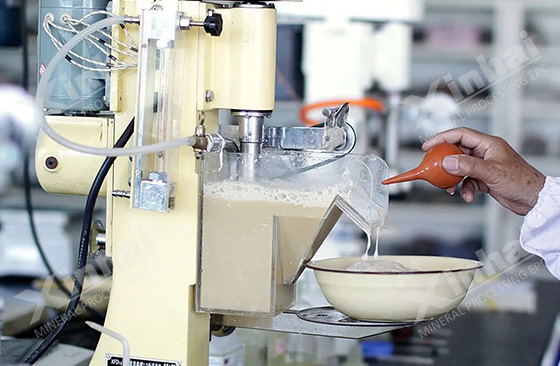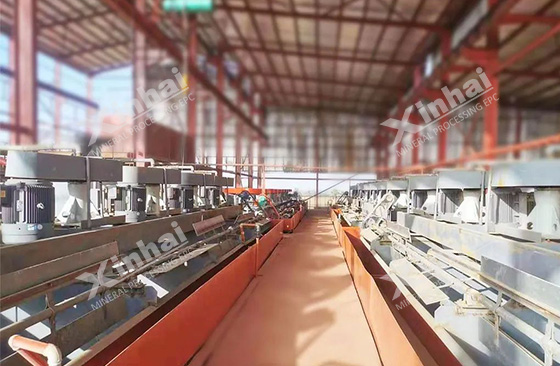As an important strategic resource, fluorite ore is widely used in many fields. The main gangue minerals of fluorite include the following: calcite, quartz, barite, and sulfide minerals. They usually affect the grade and recovery rate of fluorite, and they need to be separated through mineral processing methods. In this article, we discuss the beneficiation and separation methods of fluorite ore and these gangue minerals.

Use the table of contents below to navigate through the guide:
01Fluorite ore and Calcite
Calcite is a carbonate mineral containing calcium carbonate and has a similar crystal structure and density to fluorite. Calcite has good floatability under weakly acidic or neutral conditions, but poor floatability under strongly acidic or alkaline conditions. Separating fluorite and calcite is a common beneficiation problem because both minerals contain reactive Ca2+ ions, causing them to have similar floatability. In order to achieve effective separation, appropriate flotation methods and reagents need to be used. The following are several methods for separating fluorite and calcite:

Adsorption wash flotation method: This method uses sodium lauryl sulfate as a collector, and then separates them by washing and flotation. This method can achieve high-grade fluorspar concentrates.
Amide collector flotation method: This method uses amide collectors, such as oleoylsarcosine as a collector, and quabachol as an inhibitor, to perform flotation under pH 8-9 conditions. This method can obtain acid grade fluorite concentrate from raw ore containing more than 6% calcite.
Citric acid-sodium fluoride-linoleate flotation method: This method uses citric acid as an inhibitor, sodium fluoride as a regulator, and linoleate as a collector to float at pH 9. select. This method enables highly selective separation of fluorite and calcite.

02Fluorite ore and Quartz
Quartz is a silicate mineral containing silica that has a different crystal structure and density than fluorite, but similar buoyancy properties. Quartz has good floatability under neutral or weakly alkaline conditions, but poor floatability under strongly acidic or alkaline conditions. The following methods can be used when achieving separation of fluorite ore and quartz:
Use sodium carbonate to adjust the pH between 8-9, use fatty acids to collect fluorite, and use water glass to suppress quartz.
Glucose or tannin extract is used as the activator of fluorite, barium oxide is used as the inhibitor of quartz, and fatty acid is used as the collector of fluorite.
Water glass, alkaline starch and sodium hexametaphosphate are used as mixed inhibitors, saponified oleic acid is used as a roughing collector for fluorite, and water glass and citric acid are used as cleaning mixed inhibitors.

03Fluorite ore and Barite
Barite is a sulfate mineral containing barium sulfate and has similar floatability properties to fluorite. Barite has good floatability under neutral or weakly alkaline conditions, but poor floatability under strongly acidic or alkaline conditions. Therefore, during the flotation process, appropriate pH values and inhibitors must be selected based on the properties of the raw ore and the target grade.
Sodium sulfate and alkaline starch are used as mixed inhibitors, and tf2-8 is used as a collector to inhibit barite at a pH value of approximately 8.5.
Use glucose or tannin extract as the activator of fluorite ore, use barium oxide as the inhibitor of barite, and use fatty acids as the collector of fluorite.
Plant extracts and sodium fluorosilicate are used as inhibitors, and sodium oleate is used as a collector to flotate fluorite and barite respectively under neutral conditions.

04Fluorite ore and sulfide minerals
Sulfide minerals refer to metal compounds containing sulfur, such as pyrite, galena, sphalerite, etc. Sulfide has good floatability under neutral or weakly acidic conditions, but poor floatability under strongly acidic or alkaline conditions. The following methods can be used when separating fluorite and sulfide minerals:
Use xanthate to capture sulfide, fatty acid to capture fluorite, and water glass or alkaline starch to inhibit sulfide.
Use citric acid as an inhibitor, sodium fluoride as a regulator, and sulfonic acid oleic acid as a collector to selectively flotate fluorite.
The above is an introduction to the beneficiation and separation methods of fluorite ore and gangue minerals. In actual production, due to the different properties and grades of raw ores, appropriate flotation methods and reagents need to be selected according to specific conditions. Therefore, it is very important to conduct mineral processing tests to determine appropriate process parameters and dosage of chemicals, improve the recovery rate and grade of fluorite ore, and reduce production costs and environmental pollution.


 marketing@ytxinhai.com
marketing@ytxinhai.com  0086 13810327080
0086 13810327080 






































































































 CHAT
CHAT MESSAGE
MESSAGE







